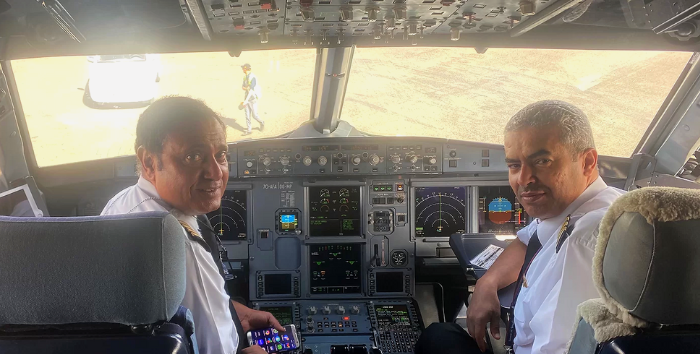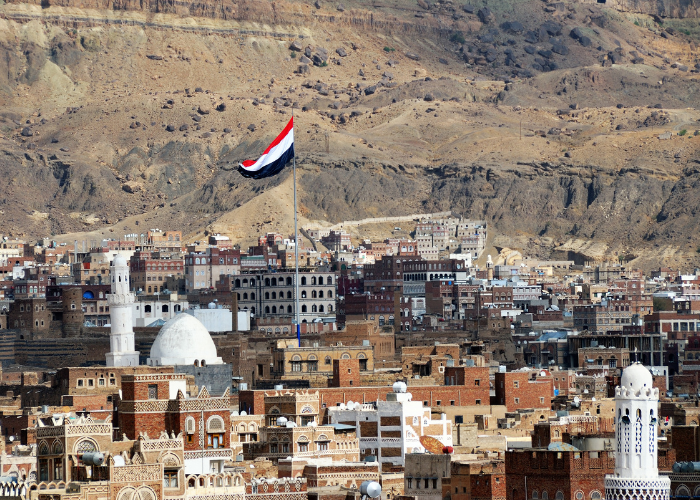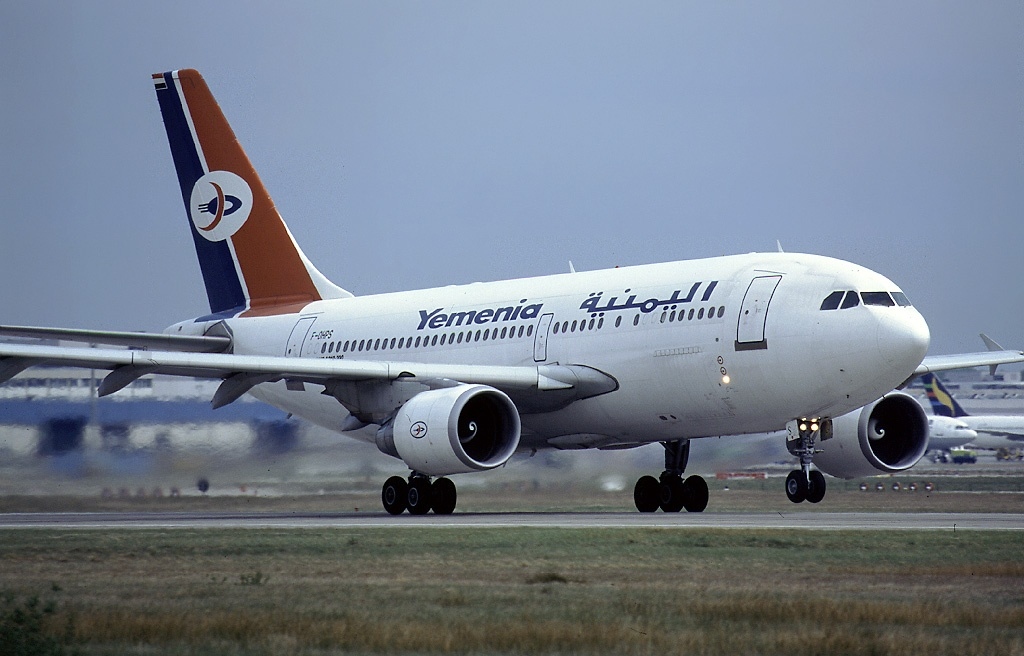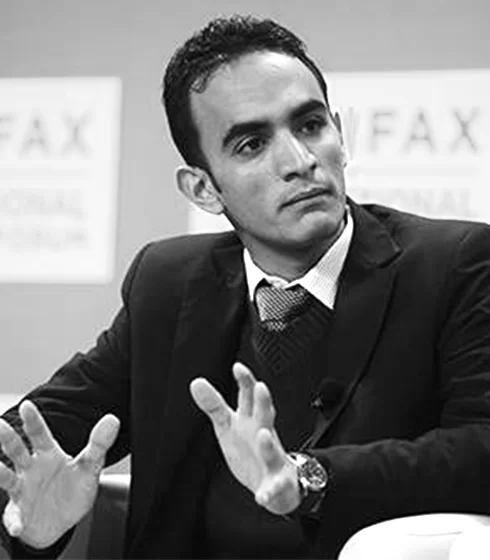By Farea Al-Muslimi
Elegantly dressed in the pilot uniforms of Yemenia Airways, Captain Khattab al-Naami, born in Taiz, and co-pilot Mohammed al-Ansi from Al-Jawf, looked nervous, as if they were about to take their first flight test. They were in fact about to fly one of the most important flights in Yemen’s history. The atmosphere was joyous as passengers awaited the departure of the flight from Amman to Sana’a on May 16. It marked the reopening of Yemen’s main airport to commercial flights nearly six years after its closure, with expectations raised in June that routes may expand further.
Just hours before Flight 649’s take-off, Al-Naami was unsure if the flight would happen, despite clearance from the Saudi-led coalition that has controlled Yemen’s airspace since entering this war in 2015. A UN-sponsored truce that took hold in April secured the limited resumption of passenger flights through Sana’a, but a first scheduled flight already had been canceled at the last minute.

Anxious passengers gathered in front of the departure board as the word Sana’a finally appeared on the screen. On boarding, a flight attendant who introduced herself as only “Baghdad”, from Al-Mahwit governorate west of Sana’a, smiled enthusiastically, greeting each traveler like someone receiving family after years of absence. Even now, passengers whispered their disbelief, predicting the flight wouldn’t take off, just like the last time.
A Group Celebration
At first there was an eerie silence as passengers settled into their seats, some with tears in their eyes. Then, men and women began using their phones to take photos documenting the moment – one of the few occasions on a plane when the conservative mores of Yemeni society have been set aside. Normally, you would hear calls of “women around, no photographs, please!”
At the back of the plane, an old man with a nasal tube connected to a medical device found enough space to stretch freely in silent pain. Having exhausted treatment options, he was returning to live out his last days at home. Like him, most passengers had left Yemen seeking medical treatment in Amman and Cairo. A small number were students, expatriates or business travelers. A few could be classified as tourists: Amman is a transit point for Yemeni expatriates in America, coming from the land of Uncle Sam to spend their holidays in the city of Sam, one of the ancient names of Sana’a.
A young man from Bani Shaddad in Khawlan, east of Sana’a, said he had come to Jordan in 2018 to work in a factory. He paid 260 Jordanian dinars – more than a third of his monthly salary – just to change the destination of his flight from Aden to Sana’a. He rebuked my surprise over the large amount he had paid, saying it was worth it to have “lunch in Sana’a.” His family, he said, hadn’t believed him when he called the previous evening to say he would be home the next day.
Conversations on flights into Yemen from Amman and Cairo often are interrupted by the voice of a flight attendant asking, “Is there a doctor or nurse among the passengers?” as a patient’s condition worsens. Last February, Al-Naami landed back at Aden airport minutes after take-off, trying to save the life of a patient traveling to Cairo to seek treatment for cancer. The woman died just before touching back down in Aden, but the captain won the appreciation and heartfelt tears of the passengers, including those who missed their transit in Cairo, for risking his livelihood by violating war-time aviation instructions to try and save another human life. Al-Naami’s behavior was a common act of humanity understood by ordinary Yemenis, who are often frustrated by the seemingly indifferent behavior of the country’s political leaders.
Suddenly I find Baghdad shouting at me, “You disappointed us!” – as if I was the spokesperson of the Yemeni Passengers Syndicate, or perhaps just because she saw me holding a pen and paper like an official note-taker. She then explained her surprise at the small number of passengers on board – the same aircraft had flown from Sana’a to Amman with more than 150 passengers, while the return flight had only 60. In other words, unlike any flight attendant one would imagine, she was disturbed rather than relieved by the small number of passengers on board, as if people had bailed on her eldest son’s wedding party.
Meanwhile, Al-Naami and Al-Ansi were literally racing against the sun to land in Sana’a, deplane their passengers, many of whom required extra time and assistance, then take off again before nightfall. The airport’s runway lost its lighting due to coalition bombing, making it impossible to take off or land after sunset. But despite the delay in Amman, the plane landed safely 28 minutes ahead of schedule, thanks to the skill of its pilots. Al-Naami, the son of the late Captain Abdullah Al-Naami, who was also a pilot, graduated from flight school in Texas in 1992 as did his co-pilot, Al-Ansi, in 2003.
At the other end, almost 2,000 kilometers away in Sana’a, air traffic controller Mutassim Abdelsalam woke up at six in the morning to begin his shift. Mutassim and his seven colleagues began working at Sana’a International Airport at the same time in 2017 but had never once guided a commercial flight down to safety. Today was a special day, however. Abdelsalam shaved and dressed up as if it was Eid, as he put it. He and his colleagues also celebrated the incoming flight with a special breakfast their infrequently paid salaries could hardly afford: Sanani-style lamb kebab. Mutassim said his heart almost missed a beat when he heard the Yemenia pilot calling through the radio, “Sana’a tower, Sana’a tower?” He later said he was so happy he would have gone down from the tower to book the pilot a taxi and then prepared his breakfast, too, if he’d wanted.

Civilian Travel in Wartime: A Journey through Hell
According to Al-Naami, about 80 percent of Yemenia pilots and their families live in Sana’a, but with Sana’a airport closed, they were forced to travel by road back and forth to Aden or Sayoun to carry out their flight duties. With the war, checkpoints and closed roads, this journey had often been hellish, and periodically impossible, at times forcing pilots close to their 100 hours per month maximum flying hours as they covered for colleagues who couldn’t make it for their shifts.
Before the war, there were 39 land, air and sea ports connecting Yemen with the outside world, according to Naser Shuraif, Vice Minister of Transportation. Most of them subsequently closed. Until the day of Flight 649, Yemenia had only four airplanes serving its entire population of 30 million people. Sana’a airport and Al-Rayyan in Mukalla, Hadramawt, which is under UAE control, have been closed to commercial flights throughout those years. The airports in Hudaydah and Taiz, two cities crushed by fighting and siege, also stopped running. All this generated a general sense of injustice among Yemenis that local and international parties were out to humiliate them and isolate them from the rest of the world.
Before the war, one could buy a plane ticket from Sana’a to Cairo or Amman for US$300. Today, the taxi fare alone from Sana’a to Aden airport is US$400, meaning for residents of northern Yemen in particular, leaving Yemen had become an expense only the upper class could afford. Patients with critical medical conditions often sell what they have or borrow beyond their means to travel abroad to seek treatment. Amman and Cairo have been the traditional destinations, particularly after the 2003 invasion of Iraq put Baghdad out of bounds.
The closure of Sana’a airport worsened people’s suffering in other ways. For Yemenis, particularly the majority who live in the north, the pain begins with having to travel 24 hours to Sayoun airport in Hadramawt or between 12 and 18 hours to Aden airport. With the usual routes closed, the journey involves passing through various broken, unpaved and unlit sections of road, leading to accidents that have claimed the lives of entire families. To make matters worse, there is the proliferation of security checkpoints where people are abducted on the basis of political or other affiliation, or kidnapped for extortion, as well as the proliferation of militias, battlefronts and landmines. Regardless of age or health condition, travelers also are subject to humiliating inspections, while restrictions are imposed on women’s movement through the obligation to travel with a male guardian, or mahram.
Just the thought of having to pass through the Houthi-controlled security checkpoint “Abu Hashim’s” in Al-Bayda, or the Islah-affiliated security checkpoint at Al-Falaj in Marib, or any point between Ibb and Al-Dhalea controlled by the Southern Transitional Council, is enough to make anyone planning to travel from Sana’a think twice about making the journey at all, even if it was to save their lives.
Getting a passport has also become a trial. Someone residing in Houthi-controlled areas is obliged to get their passport issued from areas under the control of the internationally recognized government. This forces people to move and bear much higher costs than the normal passport fee — that is if the authorities do not run short on passport books as they have in the past. One of the passengers on Flight 649 paid 900 Saudi riyals to obtain a passport through connections, rather than wait for weeks in Aden.
Finding Hope in a Sky That Has Brought Years of Pain and Fear
Children born in Sana’a during the almost eight years of war are familiar with the sounds of coalition airstrikes coming from overhead, and the airport has been one of the most prominent targets. Flight 649 began to reshape Yemenis’ relationship with their sky, from being a domain of death to a source of life and hope. And possibly peace.

The current truce is the biggest breakthrough for many years. Keeping Sana’a airport open is necessary, regardless of the fate of the truce. All that is needed to ensure this can happen is what Al-Naami calls a “dudes’ agreement.” But there has been no final agreement yet among the “dudes” — the most-powerful Yemeni players on the political and battle fields. And although Houthi authorities are willing to make concessions to external forces — such as border security assurances to Saudi Arabia — they refuse any positive gestures to Yemenis, still stalling on easing their suffocating siege of Taiz.
As soon as the plane’s doors opened, able-bodied passengers jumped to the ground to dance in joy or to thank the heavens. They headed for immigration, largely ignoring journalists who turned up seeking comments. The passport officer took some time to activate the dusty passport machine, which finally sputtered to life as though it hadn’t been used in years and could barely recognize a passport.
Outside, Sana’a was what it always has been: a city that forgot to die. Hunger has decimated its people and the war has broken many people’s honor in various ways. But it has not defeated them. Uncle Faisal Said’s qat diwans, for example, were still full of singers, artists and poets who managed to find their way in. And the dancing of 80-year-old Uncle Mohammed al-Raymi to the tunes of a young oud player inspires life, love and hope. For more than a moment, it makes one almost forget that there is war and misery just outside the window.
Two weeks after the first commercial flight into Sana’a, the truce was extended for another two months. Captain Al-Naami also flew the first passenger flight from Sana’a to Cairo and back on June 1, though it was the only such flight due to an unexplained problem Egyptian authorities had with flights from Sana’a. He also relayed one more piece of good news for everybody: Rosa Abdelkhaleq, until recently a co-pilot, now flies an Airbus 320 for Yemenia, becoming the first female captain in the history of the Republic of Yemen.
At the outer gate of Sana’a airport, some dozen people who made their living as porters and helpers before the shutdown of the airport were waiting in an effort to win a new customer. As soon as I stepped out as the first passenger, one of them hit me with, “Is this the Yemenia Airways flight?” Without thinking, I answered “Aiwa!” — Yes! in my Yemeni accent. He and everyone around him chuckled at the joke I had just missed. “It’s been a while since we’ve seen a passenger, what can we do, brother?” he said.
This post was originally published by the Sana’a Center for Strategic Studies and is available in Arabic at Assafir al-Arabi.

Farea Al-Muslimi is the chairman and co-founder of Sanaa Center for Strategic Studies. He is also an Associate Fellow at Chatham House. He previously worked for the Carnegie Middle East Center in Beirut and Middle East Institute in Washington, D.C. as a visiting scholar where he covered Yemen and the Gulf.
In August 2016, UN Secretary General Ban-Ki Moon appointed Al-Muslimi to the Advisory Group of Experts for Progress Study on Youth, Peace and Security, a study mandated by Security Council resolution 2250 to examine the positive contribution of youth to peace processes and conflict resolution and effective responses at local, national, regional and international levels.
Al-Muslimi’s writings and analysis on Yemen and the wider region have been published in Foreign Affairs, Foreign Policy, New York Times, The National, The Independent, The Guardian, Al-Hayyat, Assafir Arabi, Al-Monitor, and many other publications.
If you enjoyed this article, you may also like:
10 Incredible Yemeni Women To Add To Your Feed
The Best Middle East and North Africa Podcasts in 2022 – Politics & History






